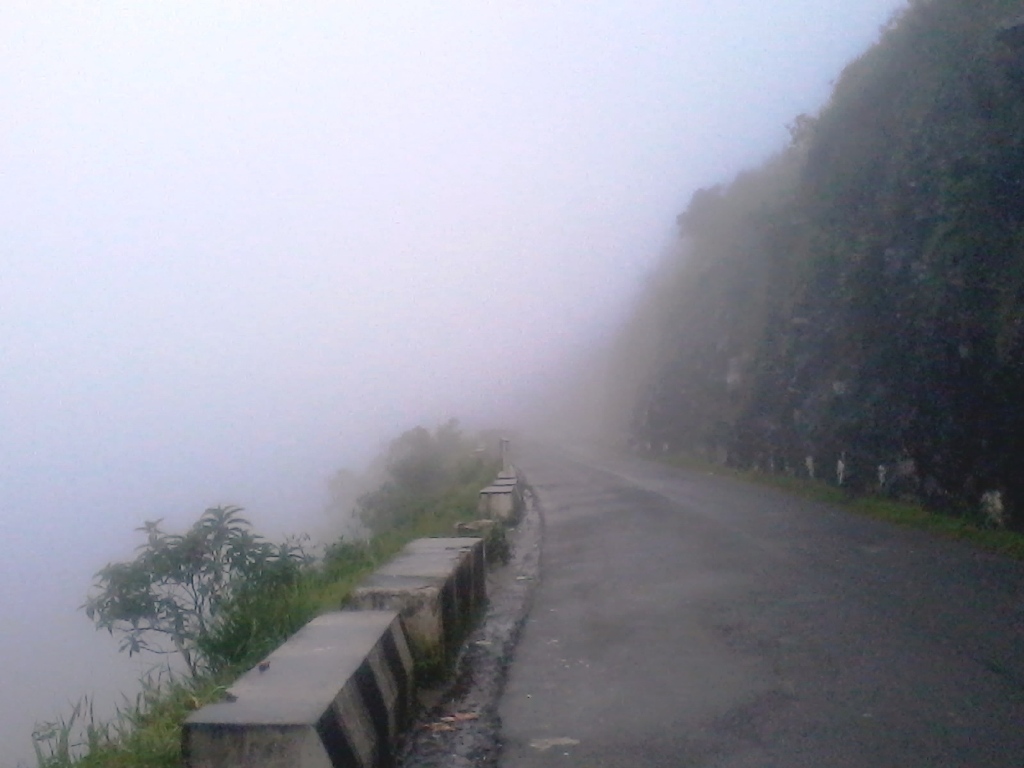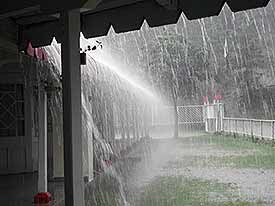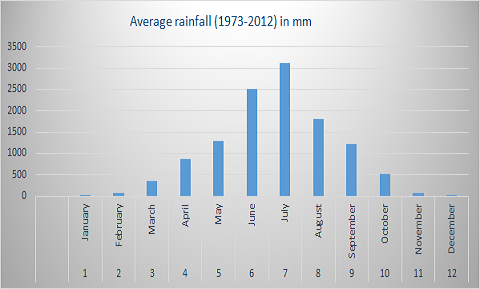
335 m tall Nohkalikai Falls falling from Cherrapunji plateau are fed just by 2 km long stream. Without heavy rains it would be much smaller.
Cherapunjee (the old and lately returned name - Sohra) is a town located on high plateau in Khasi Hills, rising 600 m above surroundung valleys. This is beautiful, fairy-tale landscape, some 1,200 - 1,400 m above the sea level. Contrary to the plains of Bangladesh further south, here almost never gets hot: for most part there is pleasant 24°C temperature. Only the dry winters might become unpleasantly cold - sometimes it is almost freezing.
As the spring ends, by the third week of May the weather in Khasi Hills becomes very humid. There has started monsoon - nearly constant wind blowing from the Bengal Bay and Bangladesh to the dry Tibetan plateau which at this time of the year has low atmospheric pressure. Air masses gather lots of humidity from the baking hot swamps of Bangladesh and sea in Bengal Bay. Wind blows without obstacles over the extremely flat plains of Bangladesh, which 400 km from the sea rise only 10 - 30 m above the sea level. But, as the humid, heated air masses reach Khasi Hills, over 8 - 9 kilometre distance they reach 1,200 - 1,400 m tall mountains. The abrupt change in conditions leads to extremely heavy downpours of rain, which are expecially powerful on the southern slopes of Khasi Hills.
Another reason for powerful rain is the proximity of Cherrapunji to the line of discontinuity between the dry eastern and northern winds and moist southern and western winds. Powerful rains and high cliffs lead to another spectacular phenomenon - tall waterfalls. Khasi Hills contain several of the most impressive waterfalls of India. Especially great are the approximately 335 m tall Nohkalikai Falls near Cherrapunji. World records
Different sources give different number for medium annual rainfall in Cherrapunji - from 10,816 mm to 12,063 mm of rain per year. More than 80% of rains in Cherrapunji fall in summer: in May - September. Remaining part of the year gets a lot less rain and there might be even droughts in winter, when local people (living in one of the wettest places of the world!) have hard time to get any water. It has happened though that daily rains have lasted here for two years.
As Brits moved in this beautiful land, they noticed the extreme rainfall. Meteorological observatory was established in 1902 in convenient location - Cherrapunji town. Before 1902 there were raingauges installed in several locations of Cherrapunji and thus climatic record is available since 1871 - a luxury which is rare even in many parts of Europe.
Several world records of rainfal Here have been measuredl:
- Yearly rainfall - 24,555 mm in 1974.
- Rainfall in one month - 9,300 mm in July 1861.
Some believe that Cherapunji holds the record for rainfall in one day - 1,563 mm in 15th - 16th June 1995, measured in 8:30 one day - 8:30 next day. Three times more than it rains in London PER YEAR! In European or American cities even 5 minutes of such rain would lead to flash floods and make headlines in newspapers, but here it continued for a whole day - for 1,440 minutes! But this record has been beaten elsewhere - at Cilaos, Reunion Island, where in 15 - 16 March 1952 was registered 1,870 mm rainfall!
Most rain in Cherrapunji falls in early morning hours, as the moist air rises from valleys, where it has been trapped in the night.

Thick mist during Rainy seasons

An early morning downpour
Rainfall in Cherrapunjee (40 years average 1973 - 2012) |
|||||||||||||||||||||||||||||||||||||||||||||
|
 |
||||||||||||||||||||||||||||||||||||||||||||